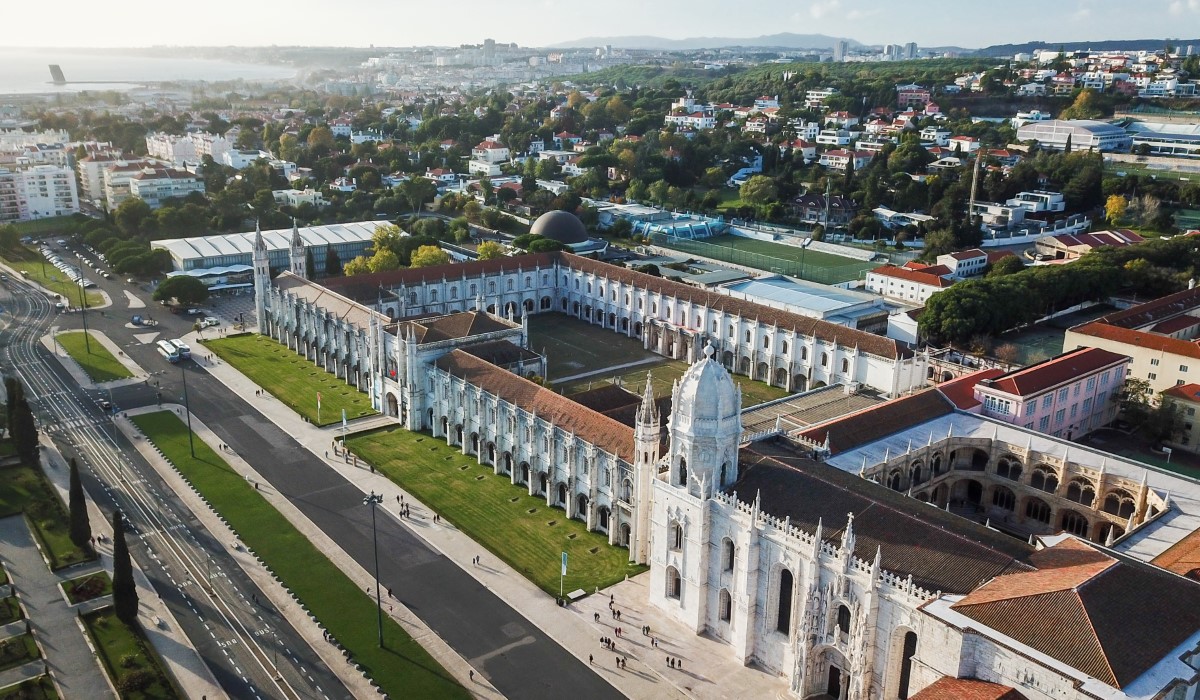Lisbon is not only a hub of culture and history, but it also serves as the gateway to several remarkable UNESCO World Heritage Sites that lie just beyond the city. These destinations offer an opportunity to explore Portugal’s rich heritage, showcasing grand monasteries, royal palaces, and stunning cultural landscapes that have played significant roles in the country’s history.
Here are the 5 UNESCO World Heritage Sites you must visit around Lisbon.
1. Jerónimos Monastery – A Testament to Portugal’s Age of Discovery
Located in Belém, the Jerónimos Monastery (Mosteiro dos Jerónimos) is one of the most celebrated monuments in Portugal and a stunning example of Manueline architecture. Built in the 16th century, this magnificent monastery was commissioned by King Manuel I to commemorate Vasco da Gama’s successful voyage to India. It is a grand symbol of the wealth and power Portugal gained during its Age of Discovery.
Highlights:
- Manueline Style: The intricate stonework on the façade, adorned with maritime and religious motifs, is a perfect representation of the Manueline architectural style.
- Tomb of Vasco da Gama: The monastery is home to the tomb of Portugal’s greatest explorer, Vasco da Gama, as well as the renowned poet Luís de Camões.
- Cloisters: The beautifully carved cloisters are considered some of the finest in Europe, featuring elaborate arches and an almost serene atmosphere for contemplation.
A visit to Jerónimos Monastery is a journey into the heart of Portugal’s maritime heritage and architectural mastery.
2. Belém Tower – A Historic Fortress on the Tagus River
Just steps from Jerónimos Monastery, the Belém Tower (Torre de Belém) stands as one of Lisbon’s most iconic landmarks. Built in the early 16th century, the tower originally served as a defensive fortress and ceremonial gateway to the city for ships arriving from the sea. It is a stunning example of Manueline military architecture, with its unique mix of Gothic, Moorish, and Renaissance elements.
Highlights:
- Ornate Architecture: The tower’s façade is decorated with intricate maritime symbols, including rope carvings and the Cross of the Order of Christ, reflecting Portugal’s naval dominance during the Age of Discovery.
- Strategic Importance: Belém Tower played a crucial role in protecting Lisbon’s harbor and is one of the few remnants of the city’s defensive structure from this era.
- Views of the Tagus: Visitors can explore the tower’s terraces and battlements, which offer incredible views over the Tagus River and surrounding areas.
The Belém Tower is not only a fortress but also a symbol of Portugal’s golden era of exploration and a must-visit site near Lisbon.
3. Cultural Landscape of Sintra – A Fairytale Escape
A short distance from Lisbon, the Cultural Landscape of Sintra is an enchanting region filled with extravagant palaces, ancient castles, and lush gardens. Recognized by UNESCO for its blend of natural beauty and man-made wonders, Sintra was historically the summer retreat for Portuguese royalty and aristocrats, who built grand residences in this cool and mystical setting.
Highlights:
- Pena Palace: One of the most recognizable palaces in Portugal, Palácio da Pena is a colorful 19th-century masterpiece that blends architectural styles, including Gothic, Moorish, and Renaissance. Its hilltop location provides sweeping views of the surrounding countryside.
- Quinta da Regaleira: This enigmatic estate is famous for its Gothic-style palace and sprawling gardens, filled with hidden tunnels, grottos, and the famous Initiation Well, a spiral staircase that descends underground in a mysterious, symbolic design.
- Moorish Castle: Overlooking the town of Sintra, the Castelo dos Mouros is a centuries-old castle offering panoramic views of the region. Its ancient stone walls and towers provide a glimpse into Portugal’s early history.
Sintra’s cultural landscape is a magical destination where history and nature combine, making it one of the most breathtaking UNESCO sites in Portugal.
4. Monastery of Batalha – A Gothic Masterpiece
A short drive north of Lisbon, the Monastery of Batalha (Mosteiro da Batalha) is one of Portugal’s greatest architectural achievements. Built to commemorate the Portuguese victory at the Battle of Aljubarrota in 1385, this magnificent Gothic-style monastery took over a century to complete. The monastery is renowned for its detailed stonework and stunning chapels, particularly the Unfinished Chapels (Capelas Imperfeitas), which remain incomplete to this day.
Highlights:
- Gothic Architecture: The monastery’s intricate façade is a stunning example of Flamboyant Gothic design, with elaborate stone carvings and soaring spires.
- Unfinished Chapels: These open-air chapels at the rear of the monastery are one of its most intriguing features, offering a dramatic display of Gothic stonework despite never being fully completed.
- Royal Cloisters: The peaceful cloisters are a perfect example of Gothic elegance, with beautifully carved arches and intricate detail throughout.
A visit to the Monastery of Batalha is a journey into Portugal’s medieval past, offering a glimpse of the country’s architectural and historical significance.
5. Monastery of Alcobaça – A Testament to Gothic Grandeur
Founded in the 12th century, the Monastery of Alcobaça (Mosteiro de Alcobaça) is one of Portugal’s most important religious buildings and a UNESCO World Heritage Site. It was the first Gothic building in Portugal and has long been a symbol of the power of the Cistercian Order. The monastery is known for its stark, simple design, yet its vast size and serene atmosphere leave a lasting impression on visitors.
Highlights:
- Tomb of Pedro and Inês: One of the most famous features of the monastery is the tombs of King Pedro I and Inês de Castro, Portugal’s most tragic lovers. Their story is one of the greatest love stories in Portuguese history, and their elaborately carved tombs, facing each other in the transept, are a poignant tribute to their love.
- Majestic Church: The Church of Santa Maria inside the monastery is one of the largest Gothic churches in Portugal, with soaring ceilings and a stunning sense of scale.
- Cloisters: The Cloister of Silence, one of the most peaceful spots in the monastery, is a beautifully preserved example of monastic architecture.
The Monastery of Alcobaça is not only a masterpiece of Gothic design but also a place of deep historical and emotional significance, making it a must-visit site around Lisbon.
Conclusion: Explore Portugal’s Rich Heritage
The UNESCO World Heritage Sites around Lisbon offer a captivating look into Portugal’s rich history and architectural achievements. From the Manueline wonders of Jerónimos Monastery and Belém Tower to the fairytale palaces of Sintra and the Gothic grandeur of Batalha and Alcobaça, these sites provide a deep connection to Portugal’s past. Each destination offers a unique experience and an opportunity to explore the country’s remarkable cultural legacy.


















































